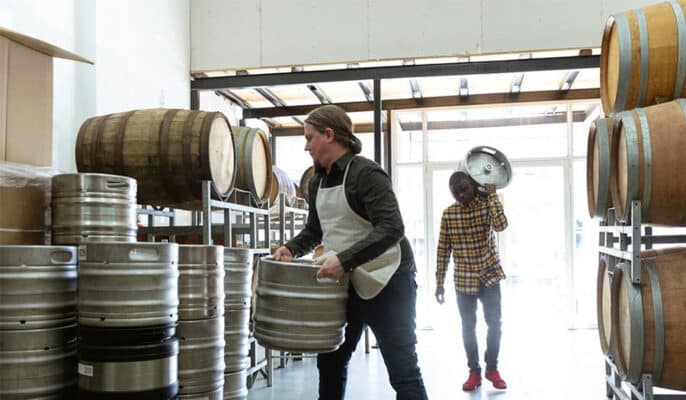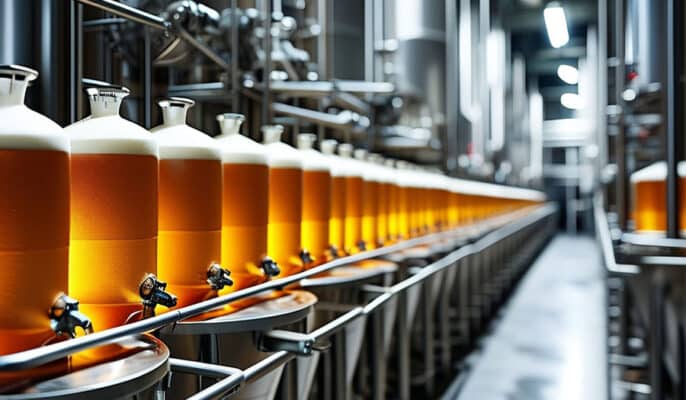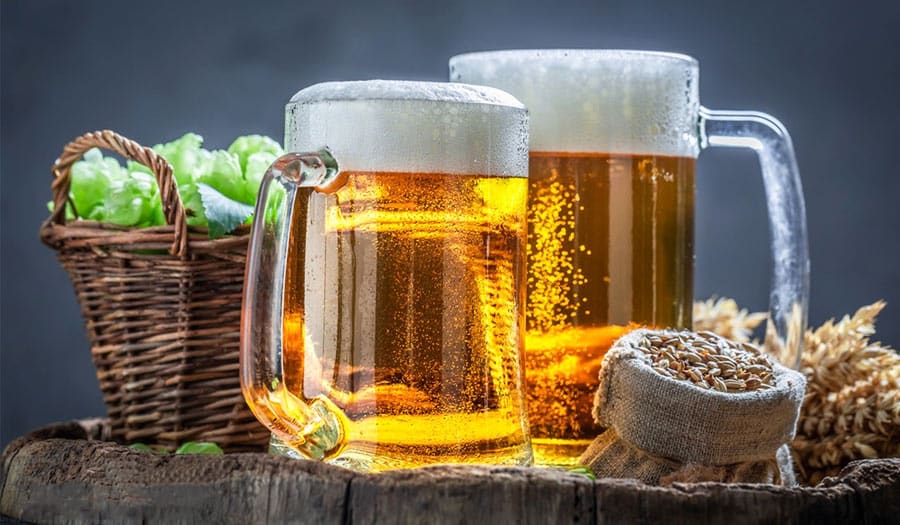La produzione di birra è un processo complesso e delicato che prevede diverse fasi, ognuna delle quali è fondamentale per il sapore, il gusto e la qualità della birra finale. In questa guida verranno analizzate in dettaglio tutte le fasi della produzione della birra, tra cui la preparazione del malto, l'ammostamento, la bollitura, la fermentazione, la maturazione e il confezionamento. Ogni fase è un anello fondamentale per garantire la qualità della birra e la piena comprensione del processo di produzione della birra.
Imparare a produrre la birra
Per comprendere la produzione della birra è necessario padroneggiare le fasi principali e i dettagli tecnici. Gli ingredienti di base della birra sono il malto, il luppolo, il lievito e l'acqua. In primo luogo, il malto, che è stato germinato ed essiccato, fornisce zucchero e sapore alla birra. Poi, durante il processo di ammostamento, l'amido del malto viene convertito in zucchero fermentabile. Il luppolo viene aggiunto durante la fase di bollitura per conferire alla birra amarezza e aroma. Durante la fase di fermentazione, il lievito converte lo zucchero in alcol e anidride carbonica. Infine, la birra viene fatta maturare a basse temperature per esaltarne il sapore. Conoscere i dettagli di ogni fase vi aiuterà a padroneggiare il processo di produzione della birra e a creare il sapore ideale della birra.

Selezione delle materie prime
Malto
La prima fase della produzione della birra è la maltazione. Il malto contiene una serie di carboidrati, tra cui cellulosa insolubile ed emicellulosa solubile, destrine, amido e zuccheri. L'amido rappresenta circa 50% - 60% del peso del malto. Per raccogliere l'amido e convertirlo in zuccheri, l'orzo viene sottoposto a un processo chiamato maltazione. L'orzo viene immerso in acqua e la parte "germinale" del seme inizia a crescere in una gemma terminale, cioè a germogliare. Dopo la germinazione, il malto viene essiccato per impedire un'ulteriore germinazione e aumentarne il sapore e l'aroma. A seconda dello stile e delle esigenze della birra, il tipo e il trattamento del malto possono variare, come il malto chiaro e il malto scuro che conferiscono alla birra colori e sapori diversi.
Luppolo
Il luppolo è un fiore a forma di cono che fornisce aroma e amarezza alla birra. L'amaro del luppolo bilancia la dolcezza del maltosio e lascia un retrogusto rinfrescante. Può anche essere usato come conservante grazie alle sue proprietà antimicrobiche. Sebbene esistano centinaia di varietà di luppolo, esse si dividono grosso modo in tre tipi: luppolo amaricante, luppolo aromatico e luppolo a doppio uso. Il loro scopo è chiaro nel nome. I diversi tipi di luppolo vengono aggiunti in fasi diverse della bollitura per creare un profilo di luppolo più complesso, dando alla birra un buon equilibrio di sapore, aroma e amarezza.
Lievito
La gestione del lievito è fondamentale per l'efficienza della fermentazione e la qualità finale della birra. I passi importanti per mantenere la vitalità e la vitalità del lievito coltivato sono il corretto lancio e la potatura del lievito, la propagazione del lievito dal laboratorio al lancio su larga scala, la conservazione del lievito per il riutilizzo e l'uso di tecniche di lavaggio acido del lievito per ridurre le infezioni. Esistono due tipi principali di lievito: Lievito Ale e Lievito Lager. I lieviti a fermentazione superiore sono solitamente fermentati a temperature più elevate e producono aromi più fruttati ed esteri, mentre i lieviti a fermentazione inferiore sono fermentati a temperature più basse e producono sapori più puliti e leggeri.
Fasi importanti della produzione di birra
Malto
La prima fase della produzione della birra è la germinazione. L'orzo fresco viene prima messo a bagno in acqua e poi collocato nelle cosiddette cassette per la germinazione. In questa fase si formano gli enzimi (amilasi) necessari per la separazione dell'amido. Il processo di germinazione viene poi interrotto nella fase ottimale dall'essiccazione (kilning). Il malto verde viene accuratamente essiccato a 80° C e ha un sapore leggermente dolce dopo l'essiccazione. Il maltosio viene quindi utilizzato per alimentare la coltura del lievito e formare l'alcol.
Fresatura
La seconda fase del processo di produzione della birra è la macinazione. Il malto finito viene macinato, come si fa con la farina, in modo che si sciolga meglio nell'acqua. I mulini producono vari tipi di malto macinato: pula, lolla, semola e grist (dal più grossolano al più fine).
Ammassamento
Il processo di ammostamento prevede l'aggiunta dei grani maltati all'acqua calda. Durante l'ammollo del malto, l'acqua calda attiva gli enzimi che scompongono l'amido e rilasciano zuccheri semplici. Dopo l'ammollo, la miscela forma una sostanza viscosa che assomiglia al porridge. Questo processo può durare da 30 a 120 minuti o anche di più, a seconda della temperatura e del tipo di enzimi. I solidi vengono quindi separati dall'acqua dolce, chiamata mosto.
Filtrazione e bollitura
Dopo l'ammostamento, il mosto deve essere separato dai residui di malto. Questo processo è chiamato Lautering. Il mosto viene quindi fatto passare attraverso un filtro, solitamente costituito da pula di malto o da altri materiali per garantire un'efficace separazione dei residui di malto. Il mosto così ottenuto viene versato in un bollitore e riscaldato fino all'ebollizione. Il processo di ebollizione non solo uccide i potenziali microrganismi, ma rilascia anche le sostanze amare contenute nel luppolo. Il luppolo viene spesso aggiunto in fasi diverse della bollitura per ottenere effetti gustativi diversi.
Raffreddamento e fermentazione
Al termine della bollitura, il mosto viene raffreddato rapidamente per evitare la contaminazione batterica ed è pronto per la fermentazione. Il lievito viene quindi aggiunto al mosto raffreddato e inizia la "magia" della produzione della birra. Nei giorni successivi, il lievito consuma gli zuccheri del mosto, producendo anidride carbonica e alcol. La durata della fermentazione varia a seconda del tipo di birra, ma di solito non supera le due settimane.
Carbonazione e maturazione
Quando il fermentazione Se il processo è considerato completo, può iniziare il processo di condizionamento o di maturazione. A questo punto, il lievito si calma e assorbe alcuni dei composti indesiderati, come l'anidride carbonica e l'etanolo. Il lievito si deposita e viene separato dalla birra insieme ad altri sedimenti indesiderati. La carbonazione avviene dopo la filtrazione della birra, ma la birra a fermentazione secondaria non ha bisogno di essere carbonata. La carbonazione ha un impatto significativo sulla sensazione in bocca, sul sapore, sull'aroma e sull'aspetto della birra.

Sistema di produzione della birra
Sistema di estrazione della birra
L'estratto di birra è un metodo comodo ed efficiente per la produzione di birra per i principianti o per coloro che hanno tempo e spazio limitati. Questo sistema utilizza principalmente estratto di malto preconfezionato (liquido o in polvere) per semplificare il processo di ammostamento. Il sistema di estrazione della birra funziona mescolando l'estratto di malto con acqua calda, facendolo bollire, aggiungendo il luppolo, quindi raffreddando e fermentando. I vantaggi di questo metodo sono la semplicità di funzionamento, i tempi brevi e i bassi requisiti di attrezzatura. Tuttavia, i suoi svantaggi possono limitare il pieno controllo del processo di produzione della birra e non possono rispecchiare appieno il sapore complesso della produzione di birra all grain.
Sistema di produzione di birra per tutti i cereali
La produzione di birra all grain è l'obiettivo finale perseguito dai birrai domestici seri. A differenza della produzione di birra a estrazione, la produzione di birra all grain utilizza malto integrale e converte l'amido in zuccheri attraverso il processo di ammostamento. Questo metodo consente il pieno controllo del processo di produzione, in modo da poter regolare il sapore e il gusto della birra. L'attrezzatura necessaria per la produzione di birra all grain comprende un tino di ammostamento, un sistema di filtrazione e un recipiente di fermentazione più complesso, il che rende l'intero processo più complicato e lungo rispetto alla produzione di birra per estrazione. Tuttavia, offre strati di sapore più ricchi e un'esperienza di homebrew unica, che la rende ideale per gli appassionati che desiderano acquisire una conoscenza più approfondita e padroneggiare l'arte della produzione della birra.
Come scegliere il giusto sistema di produzione della birra?
- Considerate i vostri obiettivi di produzione della birra: Prima di decidere in quale sistema di produzione di birra investire, dovete innanzitutto chiarire i vostri obiettivi di produzione. Avete intenzione di produrre birra per divertimento e svago personale o aspirate a creare un'attività commerciale di produzione di birra? Obiettivi chiari vi aiuteranno a scegliere il sistema più adatto e a garantire che il vostro investimento e i vostri sforzi portino il ritorno previsto.
- Budget e spazio disponibile: Il vostro budget e lo spazio disponibile influenzeranno direttamente il sistema di produzione della birra che sceglierete. In primo luogo, valutate il vostro budget, poiché i diversi sistemi di produzione di birra e le diverse attrezzature hanno costi diversi. I principianti tendono a scegliere sistemi più economici e con minori requisiti di attrezzatura, mentre i budget più elevati possono sostenere attrezzature di produzione più complesse e di fascia alta. Inoltre, è fondamentale considerare lo spazio necessario per l'attrezzatura per la produzione di birra, assicurandosi di avere spazio sufficiente per ospitare e far funzionare il sistema selezionato, considerando anche lo stoccaggio e la manutenzione dell'attrezzatura per la produzione di birra.
- Livello di esperienza nella produzione di birra: L'esperienza e il livello di abilità nella produzione di birra sono fondamentali per scegliere il sistema di produzione giusto. I principianti possono essere più inclini a scegliere sistemi di estrazione che sono facili da usare e hanno una curva di apprendimento più bassa, mentre i birrai esperti possono scegliere sistemi di produzione di birra all grain che offrono un maggiore controllo del sapore e una maggiore creatività.
FAQ
Quali sono le fasi fondamentali della produzione della birra?
- Preparazione delle materie prime: selezionare e preparare malto, luppolo, lievito e acqua.
- Mash: mescolare il malto con acqua calda per convertire l'amido in zuccheri fermentabili.
- Filtrazione dello zucchero: separare il residuo di malto dal liquido di ammostamento per ottenere un mosto limpido.
- Bollitura: far bollire il mosto e aggiungere luppolo per aumentare l'amaro e l'aroma.
- Raffreddamento: raffreddare rapidamente il mosto bollito a una temperatura adatta alla fermentazione.
- Fermentazione: trasferire il mosto raffreddato in un contenitore di fermentazione e aggiungere il lievito per la fermentazione.
- Maturazione: al termine della fermentazione, la birra viene fatta maturare a basse temperature per migliorarne il sapore.
- Confezionamento: filtrare la birra maturata e imbottigliarla o inscatolarla.
Come scegliere il lievito giusto?
I diversi stili di birra richiedono ceppi di lievito diversi. Ad esempio, per le Ale si utilizza solitamente un lievito a fermentazione superiore, mentre per le Lager si utilizza un lievito a fermentazione inferiore. L'intervallo ottimale di temperatura di fermentazione del lievito è diverso; scegliete il lievito più adatto alle vostre condizioni di produzione. Allo stesso tempo, è necessario considerare anche le caratteristiche di fermentazione del lievito, come la velocità di fermentazione, la produzione di aromi, ecc.
Qual è il ruolo della fase di maturazione?
Il ruolo della fase di maturazione è quello di permettere alla birra di sviluppare ulteriormente il suo sapore a basse temperature e di migliorarne il gusto. Durante il periodo di maturazione, il lievito e gli altri sedimenti presenti nella birra si depositano sul fondo, rendendo la birra più chiara. Allo stesso tempo, questa fase può anche bilanciare il gusto e il sapore della birra e rimuovere i sapori non necessari.




